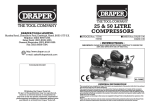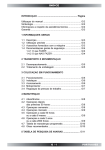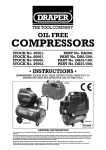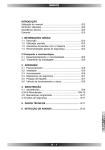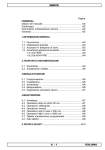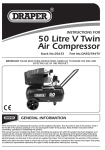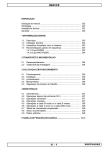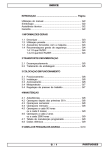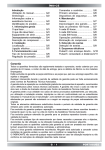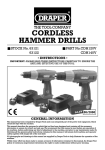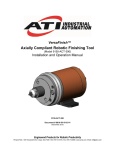Download Draper DA100 Specifications
Transcript
100, 150 & 200 LITRE COMPRESSORS ■ STOCK Nos.77709 77897 77711 ■ PART Nos.DA100/300B DA150/300B DA200/300B • INSTRUCTIONS • IMPORTANT: PLEASE READ THESE INSTRUCTIONS CAREFULLY TO ENSURE THE SAFE AND EFFECTIVE USE OF THIS TOOL. 01/2005 GENERAL INFORMATION This manual has been compiled by Draper Tools and is an integrated part of the product with which it is enclosed and should be kept with it for future references. This manual describes the purpose for which the product has been designed and contains all the necessary information to ensure its correct and safe use. We recommend that this manual is read before any operation or, before performing any kind of adjustment to the product and prior to any maintenance tasks. By following all the general safety instructions contained in this manual, it will ensure both product and operator safety, together with longer life of the tool itself. All photographs and drawings in this manual are supplied by Draper Tools to help illustrate the operation of the product. Whilst every effort has been made to ensure accuracy of information contained in this manual, the Draper Tools policy of continuous improvement determines the right to make modifications without prior warning. 100, 150 & 200 LITRE COMPRESSORS ■ STOCK Nos.77709 77897 77711 ■ PART Nos.DA100/300B DA150/300B DA200/300B CONTENTS: Contents/Declaration Specification/Guarantee Power Supply General Safety Instructions Getting to Know Your Compressor Assembly Operation and Use Maintenance Trouble Shooting 1 2 3 4 5 6 6-8 8 - 10 11 DECLARATION OF CONFORMITY We Draper Tools Ltd. Hursley Road, Chandler’s Ford, Eastleigh, Hampshire. SO53 1YF. England. Declare under our sole responsibility that the product: Stock No:- 77709, 77897, 77711. Part No:- DA100/300B, DA150/300B, DA200/300B. Description:- Air Compressors. To which this declaration relates is in conformity with the following directive(s) 98/37/EC, 97/23/EC, 2000/14/EC, 73/23/EEC, 89/336/EEC, 87/404/EEC JOHN DRAPER Managing Director 16/07/2004 -1- SPECIFICATION The Draper Tools policy of continuous improvement determines the right to change specification without notice. Stock No. Part No. Voltage Motor 77709 77897 DA100/300B DA150/300B 230V/50Hz 230V/50Hz 3HP (2.2kW) 3HP (2.2kW) 77711 DA200/300B 230V/50Hz 3HP (2.2kW) 1450 1450 145PSI (10bar) 145PSI (10bar) Air displacement 10.4cfm (295L/min) 10.4cfm (295L/min) 10.4cfm (295L/min) Free air delivery 7.2cfm (204L/min) 7.2cfm (204L/min) 7.2cfm (204L/min) 70kg 75kg Sound pressure level 73dB(A) 73dB(A) 73dB(A) Sound power level 86dB(A) 86dB(A) 86dB(A) RPM Max. pressure Weight 1450 145PSI (10bar) 88kg ALWAYS WEAR EYE PROTECTION GUARANTEE Draper Tools have been carefully tested and inspected before shipment and are guaranteed to be free from defective materials and workmanship for a period of 12 months from the date of purchase except where tools are hired out when the guarantee period is ninety days from the date of purchase. Should the machine develop any fault, please return the complete tool to your nearest authorized warranty repair agent or contact Draper Tools Limited, Chandler's Ford, Eastleigh, Hampshire, SO53 1YF. England. Telephone: (023) 8026 6355. If upon inspection it is found that the fault occurring is due to defective materials or workmanship, repairs will be carried out free of charge. This guarantee does not apply to normal wear and tear, nor does it cover any damage caused by misuse, careless or unsafe handling, alterations, accident, or repairs attempted or made by any personnel other than the authorised Draper warranty repair agent. This guarantee applies in lieu of any other guarantee expressed or implied and variations of its terms are not authorised. Your Draper guarantee is not effective unless you can produce upon request a dated receipt or invoice to verify your proof of purchase within the 12 month period. Please note that this guarantee is an additional benefit and does not affect your statutory rights. Draper Tools Limited. -2- POWER SUPPLY CONNECTING YOUR MACHINE TO THE POWER SUPPLY The machine should be connected to a 16amp power supply either using the appropriate blue 16amp plug or directly into the fused mains supply. Both of these operations should be carried out by a qualified electrician. *WARNING A plug with bare flexible wires exposed is hazardous if engaged in a live power socket outlet. WARNING THIS APPLIANCE MUST BE EARTHED. (230V ONLY) The mains lead is coloured Green and Yellow - Earth, Blue - Neutral & Brown - Live. As these colours may be correspond with the coloured markings identifying the terminals in you 16amp plug, proceed as follows. The wire which is coloured Green and Yellow must be connected to the terminal in your plug marked with the letter 'E' or by the earth symbol or coloured green or green and Yellow. The wire which is coloured blue must be connected to the terminal which is marked with the letter 'N' or coloured black or blue. The wire which is coloured brown must be connected to the terminal which is marked with the letter 'L' or coloured red or brown. -3- GENERAL SAFETY INSTRUCTIONS FOR COMPRESSORS WARNING: Please read the following instructions carefully, failure to do so could lead to serious personal injury. Read all these instructions before operating this product and save these instructions. IMPORTANT: Draper Tools Limited recommends that this machine should not be modified or used for any application other than that for which it was designed. If you are unsure of its relative applications do not hesitate to contact us in writing and we will advise you. 1. KNOW YOUR COMPRESSOR Before operating this compressor, read and fully understand the starting, operating and stopping sections in this manual. Read all labels affixed to the compressor. Learn its applications and limitations. 2. SERVICING AND MAINTENANCE Do not service or maintain this compressor until you have read and understood the maintenance section of this manual. 3. CHECK DAMAGED PARTS Before further use of this compressor, a guard or any other part that is damaged should be carefully checked to ensure that it will operate correctly and perform its intended function. Check for alignment of moving parts, breakage of parts and any other conditions that may effect its operation. A guard or other part that is damaged should be properly repaired or replaced. 4. DISCONNECT FROM POWER SUPPLY Before servicing, maintaining or replacing damaged parts ALWAYS disconnect the compressor from the power supply. 5. EARTH This compressor is equipped with an approved 3-core power cable. The green and yellow conductor in the core is the earth wire. NEVER connect the yellow and green wire to a live terminal. 6. AVOID DANGEROUS ENVIRONMENTS Do not use the compressor in damp or wet locations or expose it to rain. Keep the work area well lit. Provide adequate surrounding work space. *Not suitable for building sites. 7. KEEP GUARDS IN PLACE 8. AVOID ACCIDENTAL STARTING Make sure the power supply switch is off before connecting to the power supply. 9. KEEP CHILDREN AWAY AND MAKE WORKSHOP CHILDPROOF All visitors should be kept a safe distance from the work area. The power tools and workshop should be made childproof with padlocks, master switches or by removing starter keys. 10. NEVER LEAVE THE COMPRESSOR RUNNING UNATTENDED Turn the power supply off. Do not leave the compressor until it comes to a complete stop. 11. DO NOT OVERLOAD THE COMPRESSOR Before operating any air tool, check that the free air delivery (FAD) from the air compressor is equal or greater than that of the air tool to be used. NOTE: The compressor should not start more than nine times in one hour. 12. AIR PRESSURE Always check the air supply pressure is equal to or less than the air tool manufacturers maximum operating pressure. 13. USE SAFETY GOGGLES/MASK Wear safety goggles (which comply to a recognised standard) at all times. Normal spectacles only have impact resistant lenses. They are NOT safety glasses. Also use a face mask if a cutting operation is dusty or if spraying paint or other toxic substances. 14. USE RECOMMENDED ACCESSORIES For a complete range of recommended accessories please refer to page 10 of this manual. IMPORTANT NOTE: Residual Risk. Although the safety instructions and operating manuals for our tools contain extensive instructions on safe working with power tools, every power tool involves a certain residual risk which can not be completely excluded by safety mechanisms. Power tools must therefore always be operated with caution! -4- GETTING TO KNOW YOUR COMPRESSOR (6) (5) (7) (9) (4) (8) (16) (11) (12) (3) (10) (2) (13) (15) (1) (14) DA150/300B Shown (1) (2) (3) (4) (5) (6) Air Receiver Tank Sump Bung Pump Unit Dipstick/Oil Inlet Pulley Guard Air Filters (7) Drive Belt (8) Motor (9) Overload Protection Switch (10) Safety Valve (11) Pressure Switch (12) In-Line Pressure Gauge (13) Tank Pressure Gauge (14) Tank Bung (15) Tank Rating Plate (16) Pressure Regulator UNPACKING: After removing the packing material, make sure the product is in perfect condition and that there are no visible damaged parts. If in doubt, do not use the compressor and contact the dealer from whom it was purchased. The packaging materials (plastic bags, polystyrene etc), must be disposed of in an appropriate refuse collection container. These materials must not be left within the reach of children as they are potential sources of danger. -5- OPERATION AND USE POSITIONING: Do not stand the compressor on any surface with a 15° or greater tilt as this will lead to possible running problems. Allow a minimum gap of 50cm around the compressor to aid connection and airflow. In addition to pneumatic air tools, your compressor may be connected to several accessories suitable for blowing, washing and spraying for example. For technical specifications and detailed instructions, please refer to the instructions provided with the individual accessory. After unpacking the compressor for the first time it will be necessary to remove the plastic transit bung and replace it with the dipstick supplied. NOTE: It is advisable to store this bung, should the compressor require transporting in the future. Make sure that the level of oil ranges between the max. and the min. mark (Fig.1). After the first 50 working hours, replace the oil with one of those listed (see page 10). When the installation procedure is complete, the compressor is ready for use. Make sure the pressure switch is positioned 'OFF'. Switch on the power then position the pressure switch to the 'ON' position to start the compressor (Fig.2). When starting the compressor for the first time, leave it running for about 10 minutes with the air tap (A) or the bung on the underside of the tank completely open (Fig.3). After this time, close air tap (A) and make sure that pressure in the tank is correct and that the compressor stops automatically when the max. pressure is reached. The pressure is monitored on gauge (B) (Fig.4). The operation is automatically controlled by the pressure switch which stops the motor when the max. pressure allowed is achieved, and starts it again when the pressure goes below the minimum threshold (about 2 bar less than the max. pressure). Never unplug the compressor or switch off the main switch to stop the compressor. Always position the pressure switch to the off position. Fig.1. Fig.2. Fig.3. (A) Fig.4. (B) -6- OPERATION AND USE ADJUSTING THE PRESSURE SWITCH (Fig.5): Note: This is the only operation where it is acceptable to switch the compressor off without using the pressure switch. To decrease the pressure switch, run the compressor up to the desired capacity for the pressure switch to be set. At this point, turn the mains power off and do not operate the red button on the pressure switch as this will release the pressure. Disconnect the machine from the power source before loosening screw (D) to remove the cover. With this removed, the adjustment bolt (C) will be visible. Adjust this anti-clockwise gently until the switch is heard to release the pressure. Replace the cover and tighten the screw. The switch will now be set to the new pressure. To increase the pressure switch, remove the switch cover (having disconnected the machine from the power supply) and turn the adjustment bolt clockwise 3 turns and replace the switch cover. Run the compressor up to the desired capacity for the pressure switch to be set (do not let the compressor run past its maximum pressure). At this point turn the mains power off and disconnect from the supply. Remove the cover and adjust the bolt anti-clockwise gently until the switch is heard to release the pressure. Replace the cover and tighten the screw. The switch will now be set to the new pressure. (C) Fig.5. (D) HOW TO ADJUST WORKING PRESSURE (Fig.6): See in the instruction manual for the rated pressure value of the accessory you are going to use. By means of the pressure reducer (E) you can adjust delivery air pressure. Just turn the knob clockwise to increase the pressure or anti-clockwise to decrease the pressure. Check the operating pressure value on pressure gauge (F). After having used your compressor, set pressure to zero by turning knob (E) so as to avoid damaging the pressure reducer. Fig.6. (E) (F) -7- OPERATION AND USE OVERLOAD CUT-OUT (Fig.7): The compressor is equipped with an overload cut-out (G) which operates as a safety device to protect the motor. The device will activate in case of motor overload or overheating due to operation troubles. In this case, the safety device will automatically activate, disconnecting the compressor and avoiding possible motor damages. To restart the compressor, proceed as follows: - Allow three minutes. - Position the pressure switch to"0" OFF. - Manually reset the thermal cut-out. - Position the pressure switch to "1" ON. If you restart the compressor and the overload cut-out releases again, turn the main switch to position "0" OFF, unplug the equipment and contact the Authorized Service Centre. If disconnection is required from the air tap assembly, ensure the tap is fully closed to stop air loss from the tank. NOTE: After reconnection is complete, ensure that the tap is opened again. It is essential to connect air line, air filter separator and lubricator to ensure a good, clean air supply is provided for the tool. (NOTE: If the intended tool for use is a spray gun, use only a filter separator as lubrication will cause contamination of the material being sprayed). Draper Stock No.51857 - Air Filter, Regulator & Lubricator. Draper Stock No.51858 - Air Filter & Regulator. To ensure an optimum air supply, please refer and carry out the following procedures as recommended Fig.7. (G) MAINTENANCE Some of the operations listed in this section will require the compressor to be returned to an Authorized Service Agent. Before carrying out any service or routine operation to your compressor, ensure the power has been disconnected and all pressure has been released from the tank, so as to prevent any sudden unexpected restart. After any maintenance operation, make sure all components have been fitted correctly. -8- MAINTENANCE In order to keep your compressor in good working conditions, we recommend you to perform periodical servicing operations. Before performing any maintenance operation, switch off the compressor and ensure all air in the tank is released. Fig.8. OPERATIONS TO BE CARRIED OUT AFTER THE FIRST 50 WORKING HOURS: Check that all screws are properly tight, paying special care to the head and crank case. Replace the lubricant with one of the recommended oil listed in the table (page10). Never mix different oils together. Do not use non-detergent oils or low quality oils as they have very poor lubricating properties. Do not pour out oil in the environment. Always contact your local body in charge of the collection. (H) Fig.9. WEEKLY OPERATIONS: Check the oil level and if necessary top up. Do not exceed the mark corresponding to the max. level. Make sure the oil does not drop below the minimum so as to avoid any damage or seizure. Drain condensation, while the tank is pressurised by opening the valve (H) located under the tank. Open the valve by turning it anti-clockwise (Fig.8) with a container under the valve. Keep the compressor in a position to allow all condensation to flow out completely. (I) Fig.10. MONTHLY OPERATIONS (OR MORE FREQUENTLY IF THE COMPRESSOR OPERATES IN VERY DUSTY AREAS) (Fig.9): Remove the suction filler (I) and replace or clean the filtering component. Do not operate the compressor without the suction filter fitted, as foreign bodies or dust could seriously damage the inside components. (J) OPERATIONS TO BE CARRIED OUT EVERY 6 MONTHS (Fig.10): Pull out the oil dipstick and loosen the screw (J) to change the oil. Collect the oil into a suitable container. You should perform this operation when the compressor is hot so as to allow the oil to drain rapidly and completely. Tighten the screw (J) in its housing and pour in the new oil up to the max. level and no higher. -9- MAINTENANCE It is advisable to clean all the finned parts of your compressor, so as to keep the cooling system efficient and to ensure a long work life to your machine. Check belt tension. Hang a weight of about 3kg at the midpoint of the belt. The belt should flex about 10mm. (Fig.11). If necessary, tension up the belt taking care not to disturb the pulley-to-flywheel alignment (Fig.12). Fig.11. OPERATIONS TO BE CARRIED OUT EVERY 2 YEARS: Check the non-return valve and if necessary replace the seal. Check intake and delivery valves on valve plates. Recommended Oils: Recommended oils with ISO 100 viscosity for compressors, in accordance with DIN51506VDL 100-E Standards and ISO6521:L-DAC Specifications (suitable for room temperature ranging from +6°C and +25°C). AGIP API BP CASTROL ESSO IP MOBIL FINA SHELL TOTAL DICREA100 CM-8X ENERGOL CS100 AIRCOL PD100 EXX OLUB H150 CALATIA OIL ISO 100 RARUS 427 EOLAN AC 100 COREMA OIL H100 CORTUSA 100 Fig.12. Use oils with an ISO 46/68 viscosity for a room temperature ranging from 0°C to + 5°C Use oils with an ISO 150 viscosity for a room temperature ranging from + 26°C to + 45°C. - 10 - TROUBLE SHOOTING USE ONLY ORIGINAL SPARE PARTS, AVAILABLE AT ALL AUTHORIZED SERVICE CENTRES. FAULT POSSIBLE CAUSE REMEDY Pressure drop in tank Air leaks at connections Allow the compressor to reach max. pressure allowed. Switch it of and brush a soapy water solution onto all air connections. Look carefully for air bubbles flowing out. Tighten those connections where leaks are present. If the problem is still present, contact the After Sales Service. The pressure switch valve leaks when the compressor is idle Non-return valve seal defective Contact your Local Service Centre The compressor stopped and does not start Overload cut-out tripped See Page 8 The compressor does not stop even though the max. pressure allowed has been reached; the safety valve operates Incorrect Setting Contact your Local Service Centre The compressor does not get to the set pressure and overheats Compressor head gasket broken or valve faulty Contact your Local Service Centre The compressor is noisy with metallic clangs Bearing or connecting rod seizure Contact your Local Service Centre The compressor does not hold regular speed Belt is slipping Contact your Local Service Centre - 11 - NOTES - 12 - NOTES - 13 - NOTES - 14 - DRAPER TOOLS LIMITED, Hursley Road, Chandler's Ford, Eastleigh, Hants. SO53 1YF. U.K. Helpline: (023) 8049 4344. Sales Desk: (023) 8049 4333. General Enquiries: (023) 8026 6355. Fax: (023) 8026 0784. http://www.draper.co.uk e-mail: [email protected] YOUR DRAPER STOCKIST ©Published by Draper Tools Ltd. No part of this publication may be reproduced, stored in a retrieval system or transmitted in any form or by any means, electronic, mechanical photocopying, recording or otherwise without prior permission in writing from Draper Tools Ltd.
















